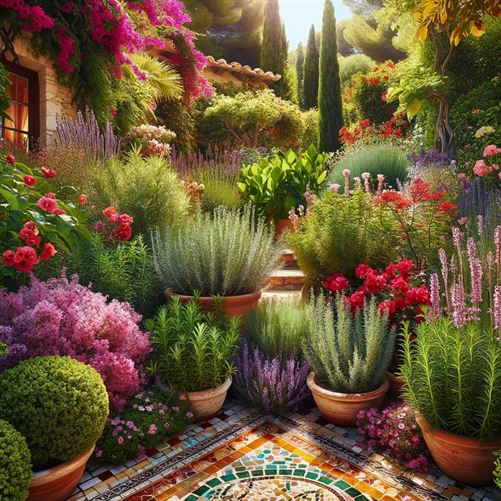Envision the sun-drenched landscapes of the Mediterranean, where vibrant, drought-resistant gardens flourish. Mediterranean gardening is an art form that combines beauty with resilience, creating serene spaces that thrive under the sun.
In this extensive guide, we’ll explore the essentials of cultivating a Mediterranean garden in your own backyard, offering a perfect blend of form, function, and sustainability.
The Essence of Mediterranean Gardening
Mediterranean gardening embodies the spirit of regions bathed in sunlight and blessed with a warm, dry climate. It’s about creating a garden that not only survives but thrives in arid conditions, using plants and techniques adapted to minimal water availability.
This style of gardening is characterized by its practicality and allure, offering a landscape that’s both functional and visually captivating.
Principles of Mediterranean Garden Design
To effectively create a Mediterranean garden, one must adhere to several key principles:

- Emphasis on Drought Tolerance: Central to this gardening style is the use of plants that require minimal water, reducing the need for frequent irrigation.
- Efficient Water Use: Incorporating techniques such as drip irrigation and mulching to conserve water is crucial.
- Soil Preparation: Well-draining soil is essential. Amending soil with organic matter can improve its structure and drainage.
- Use of Gravel and Stone: These materials reflect the natural Mediterranean landscape and help reduce water evaporation from the soil.
Selecting the Right Plants for a Mediterranean Garden
Plant selection is pivotal in Mediterranean gardens:
- Drought-Resistant Flora: Choose plants like lavender, rosemary, thyme, and other herbs that are naturally adapted to dry climates.
- Native and Adapted Species: Opt for native Mediterranean plants or those from similar climates, as they are better suited to the garden’s environment.
- Variety and Texture: Incorporate a mix of shrubs, perennials, and trees to create a diverse and textured landscape.
Irrigation Strategies and Water Conservation
Effective water management is a cornerstone of Mediterranean gardening:
- Irrigation Techniques: Drip or soaker hose systems are ideal for delivering water directly to plant roots, minimizing waste.
- Timing of Watering: Water plants during the cooler parts of the day to reduce evaporation.
- Capturing Rainwater: Consider setting up a rainwater harvesting system to collect and use rainwater for irrigation.
Design Elements in a Mediterranean Garden
Incorporating specific design elements can enhance the Mediterranean feel:
- Garden Pathways: Use natural stone or gravel paths to define spaces and add texture.
- Outdoor Seating Areas: Create spaces for relaxation and enjoyment, such as patios or shaded pergolas.
- Decorative Accents: Elements like terracotta pots, sculptures, or water features can add character and focal points.
Maintenance and Upkeep
Maintaining a Mediterranean garden involves:
- Pruning and Deadheading: Regularly prune plants to maintain shape and encourage growth.
- Controlling Weeds: Use mulching and manual removal to manage weeds effectively.
- Seasonal Adjustments: Adjust care routines seasonally, particularly in regions with wet winters and dry summers.
Gardening Under the Sun
Mediterranean gardening is a celebration of resilience and beauty, perfectly suited for dry climates.
By embracing its principles, you can create a stunning, low-maintenance garden that mirrors the charm of a Mediterranean landscape, offering a peaceful retreat in your own backyard.














